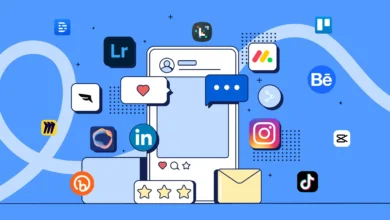Application Mobile Dualmedia: A Complete Guide to Innovation and Connectivity

In today’s fast-paced digital landscape, mobile applications have become essential tools that bridge communication, entertainment, and business. From messaging and streaming to productivity and e-commerce, apps define how people interact with technology daily. One of the latest concepts gaining attention is the Application Mobile Dualmedia, a forward-thinking approach that integrates multiple layers of connectivity and multimedia experiences into one unified platform. This article explores what application mobile dualmedia means, its features, benefits, industry applications, challenges, and the future of mobile development under this new trend.
What Is Application Mobile Dualmedia?

The term “dualmedia” combines dual (two) and media (communication or content channels). In the context of mobile applications, dualmedia refers to apps designed to handle two or more types of media content simultaneously—such as video and audio, text and visuals, or streaming and interactive chat.
An application mobile dualmedia is therefore a mobile app that integrates multiple media channels into a single, seamless experience. Instead of switching between different platforms for video conferencing, live streaming, file sharing, or instant messaging, users can enjoy everything in one integrated environment.
This type of app is not limited to entertainment; it spans across industries such as healthcare, education, e-commerce, and corporate communication. It is essentially the next stage in multimedia app evolution, where efficiency, interactivity, and connectivity merge.
Key Features of Application Mobile Dualmedia
Developers creating an application mobile dualmedia focus on combining advanced features that enhance user experience. Some of the most prominent features include:
Multi-Channel Integration
Combines video, audio, chat, and file sharing in one app.
Reduces the need for switching between multiple applications.
Seamless User Interface (UI)
A simple, user-friendly design that allows smooth navigation across media functions.
Real-Time Communication
Live chat, video calls, and instant notifications keep users engaged.
Cross-Platform Compatibility
Works on both iOS and Android devices.
Optimized for tablets, smartphones, and even wearables.
Data Synchronization
Syncs user data across devices for a continuous experience.
Security and Privacy
End-to-end encryption for calls and messages.
Secure file transfer and user authentication.
Interactive Elements
Features like polls, Q&A, and interactive feedback during live sessions.
Benefits of Application Mobile Dualmedia
Adopting dualmedia applications offers a range of benefits for users, businesses, and developers alike.
Convenience and Efficiency
Instead of juggling multiple apps for video calls, file sharing, and chatting, users can rely on one application. This reduces clutter and improves productivity.
Cost-Effectiveness
Businesses save money by integrating communication tools into a single dualmedia application rather than paying for multiple platforms.
Enhanced Collaboration
In corporate settings, dualmedia apps make teamwork easier by combining video conferencing with real-time document collaboration.
Greater User Engagement
Interactive features and multimedia integration keep users engaged longer compared to single-media apps.
Scalability
Dualmedia apps are adaptable to different industries—from education and healthcare to entertainment and retail.
Real-World Applications of Dualmedia Mobile Apps
Education and E-Learning
Online learning platforms now require video lectures, interactive chatrooms, and file sharing. A dualmedia application can integrate all of these features to create a complete virtual classroom experience.
Corporate Communication
Companies benefit from unified communication apps that support video conferencing, team messaging, and secure file transfers—all in one tool.
Healthcare
Telemedicine apps can integrate video consultations with health record sharing, patient chat, and appointment scheduling.
E-Commerce and Customer Support
Retail platforms can use dualmedia apps to provide live product demonstrations, interactive customer support chat, and secure transactions.
Entertainment and Social Media
Social apps already use dualmedia features—live video with chat overlays, interactive polls during streams, and collaborative music or video creation.
Challenges in Developing Application Mobile Dualmedia
Despite its benefits, building and maintaining a dualmedia mobile application comes with challenges:
High Development Costs
Integrating multiple media functionalities requires advanced coding, server capacity, and design, which increases costs.
Performance Optimization
Running video, audio, and chat simultaneously can strain mobile devices, leading to lags or crashes if not optimized.
Data Security Concerns
With more media channels comes higher risk of data breaches, requiring strong encryption and privacy measures.
Network Dependency
Dualmedia apps rely heavily on stable internet connections. Poor connectivity can hinder the user experience.
User Adoption
Convincing users to switch from well-established single-media apps to a new dualmedia app can be challenging.
Future of Application Mobile Dualmedia
As mobile technology continues to evolve, dualmedia applications are expected to expand even further. The integration of 5G networks, artificial intelligence (AI), and augmented reality (AR) will enhance dualmedia experiences. Some expected trends include:
AI-Powered Features
Smart translation during video calls.
AI-driven recommendations for content and collaboration tools.
AR and VR Integration
Virtual classrooms and corporate meetings in immersive environments.
Stronger Cloud Integration
Faster file synchronization across devices.
Enhanced backup and data recovery options.
Industry-Specific Dualmedia Apps
Tailored solutions for healthcare, retail, and education.
Global Collaboration Platforms
Bridging gaps between countries and languages through real-time interactive tools.
Why Businesses Should Consider Application Mobile Dualmedia
For businesses, embracing dualmedia apps means:
Improved Customer Engagement: Directly interact with customers using live streams and chat features.
Operational Efficiency: Replace multiple apps with a single, cost-effective solution.
Competitive Edge: Businesses adopting dualmedia platforms early can stand out in crowded markets.
Employee Productivity: Teams can collaborate more effectively without switching between tools.
Conclusion
The rise of the application mobile dualmedia marks a significant milestone in the evolution of mobile applications. By combining multiple media forms—video, audio, chat, file sharing, and more—into a single app, it promises unmatched convenience, engagement, and functionality for users across industries.
While challenges such as cost, security, and network dependency remain, the future potential of dualmedia apps is undeniable. As 5G, AI, and AR technologies continue to develop, dualmedia applications will become smarter, faster, and more immersive.
For individuals, it means seamless interaction and entertainment. For businesses, it’s an opportunity to enhance productivity and customer engagement. In a world driven by digital transformation, application mobile dualmedia is not just an innovation—it’s the future of connected experiences.


